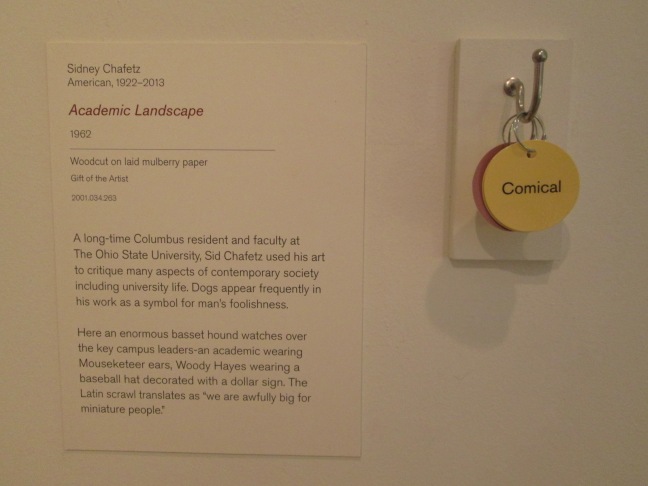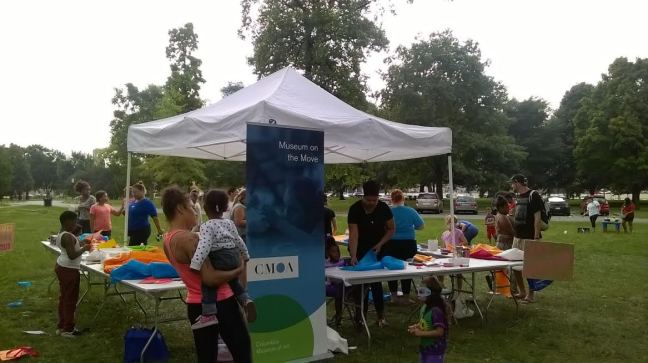I am now over three weeks into my US trip and have finished my time with the Columbus Museum of Art (CMA), the fourth case study on my tour. I am trying to hold off ‘joining the dots’ and making links between all the places I’ve seen and people I’ve met, but this tendency is starting to creep in. I had interviews with eight staff at CMA and, without fail, they all sung the praises of their Executive Director, Nannette V. Maciejunes, who is clearly a well-respected and much-loved driving force at the museum. On many occasions during these interviews, I was reminded of what others had said at the museums I’d visited previously, particularly in relation to ideas generation and wanting to try out new things. The pattern-recognition part of my brain is having a heated debate with the delay-judgement part of my brain – I’m not sure who’s winning at the moment.

During my CMA interviews, time after time the staff talked about the freeflow of ideas, how they often turn to each other to kick around a half-thought, and how comfortable they are with getting every idea on the table – good, bad or otherwise. There was a wonderful confidence in how they spoke about ideas, and their ease with the process. Similarly, there was no anxiety around binning bad ideas, trying out new stuff, and learning from things that didn’t go to plan. The culture of the organisation genuinely embraces experimentation and recognises that sometimes things don’t work, and that’s okay – as long as the learning from that experience informs future programming. I can’t overstate how strongly this came across, and how consistently I have heard this from the many people I’ve met on this trip. These people burn through ideas like a spendthrift burns through money, and they’re happy to separate their egos from the process. Their antithesis would be the Gollums of this world who guard and stroke their one golden idea, repeating ‘the precious, the precious’, over and over again under their breath…

Of the four museums I am focussing on, CMA is the smallest one with a permanent collection. The original building dates back to the 1930s and has that lovely neo-classical feel to it – all stone and columns and grandeur, albeit on a diminutive scale. A Brutalist extension added in the 1970s wasn’t considered a success, and I think many people were happy to see the back of it when it was pulled down to make way for the most recent site development project. Last year, the Margaret M Walter Wing opened, a sizable extension that wraps around two walls of the original building (think British Museum courtyard wrapping around the Reading Room, leaving the original external walls exposed). There is a new shop, cafe, sculpture garden, conference room and additional galleries. The original museum has a square floorplan with a loop of corridor around the core so it’s easy to circulate. On the first floor (or second floor if you’re American) are the galleries, which predominantly show paintings and photography, but also have sculpture, glass, textiles, and mixed media installations. They have a wonderful folk art collection, and I also got to meet another Hopper painting, Morning Sun, 1952.


On the ground floor (or first floor, depending on your proclivities) is the JP Morgan Chase Center for Creativity. These galleries and rooms are the domain of the Learning and Experience teams and include:
- Studio – a large, light workshop that can accommodate up to 35 people. The materials store cupboard would warm the heart of any educator – lots of great kit to play with, and all beautifully labelled and organised. The team use a lot of recycled materials, demonstrating that making doesn’t have to be expensive.
- Innovation Lab – I got the impression that this was the tech workshop. The Teen Open Studio on Thursday evening was using it for sound editing.
- Auditorium, Forum and Reading Room – these multi-purpose spaces are used for conferences and discussion-based or networking sessions. The Forum is located opposite the Auditorium; it was used for serving refreshments and pre-session lurking during the sessions I attended. The Reading Room is a comfortable seminar space; I saw it in action for a Docent Training session.


- Big Idea Gallery – situated along a broad corridor, ‘Dogs’ was the current exhibition when I visited. There were approximately two dozen paintings from the collection, all with a dog somewhere in the scene. There were plenty of interpretation and feedback tools too: a boardgame; a couple of jigsaw puzzles (I got sucked into the Normal Rockwell one by accident); ‘Join the Conversation’ stations where visitors could leave comments; and a selection of dog tags, labelled with adjectives, that you could hang up next to the artworks to describe the scene. I’m not that fussed about dogs, but I love puzzles and now know details in that Rockwell painting that I would never have stopped to ponder otherwise.
- Open Gallery – this space runs in parallel to the Big Idea Gallery, along the opposite side of the Center for Creativity. The current exhibition shows the work of CMA’s Graphic Novelist in Residence, Ronald Wimberly, and there’s a good mix of large quotes on the wall to catch the eye and exquisite images to slow you down and draw you in.



- Wonder Room – this space does exactly what you would want a room of wonder to do. It’s filled with nooks and hidey-holes and plenty of original objects and artworks from the collection to inspire conversation and making. There is a large tree in the centre of the room, and in one corner is an eccentric cottage that has walls pitted with miniature interior scenes. It’s intriguing, quirky and incredibly popular with audiences.



Merilee Mostov, Chief Engagement Officer, leads on interpretation at CMA. She dreamt up the Wonder Room and her fantastic creative influence is visible throughout the museum. There are ‘Join the Conversation’ stations in a number of galleries, as well as a range of activities and invitations for further thought and discussion. Best of all, Merilee understands museums to be places for social interaction and helps make visitors feel welcome by providing lots of comfortable seating – stools, chairs, benches, sofas, and armchairs. Yes, that’s right, chairs with backs and arms on them, in galleries – Hallelujah!



The Learning Department has invested a lot of time and energy into better understanding and articulating the importance of creativity, and their work is having a positive impact across the museum and into the community. Cindy Foley, Executive Deputy Director of Learning and Experience, originated this new approach at CMA and her passion, vision, and drive make her the ideal leader for supporting change. Her TED talk gives a taster of both her views on creativity and her infectious enthusiasm. I could (and probably will) devote a whole post to how CMA are promoting creativity; meanwhile, I’d like to mention how this work applies to their relationship with schools. CMA run the Teaching for Creativity Institute, a year of support and training, focussed on creativity, for a selected group of Ohio State teachers. CMA are also part-way through a research project, Making Creativity Visible, examining examples of highly creative practice in the classroom and addressing the following questions: what are the conditions in which creativity thrives, and what are the dispositions that support the creative process? The CMA Learning team seem to have found that sweet spot where theory and practice are balanced; there are plenty of large, chewy ideas to get your teeth into, and there are also plenty of programmes and activity testing and evaluating the ideas.


Beautiful photographs, beautifully described – and I love the idea of a wonder room, I want one!
LikeLiked by 1 person